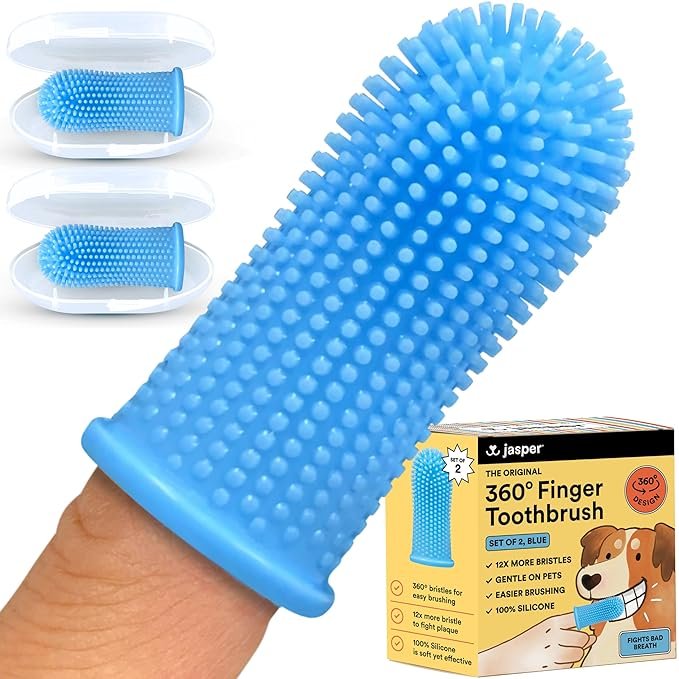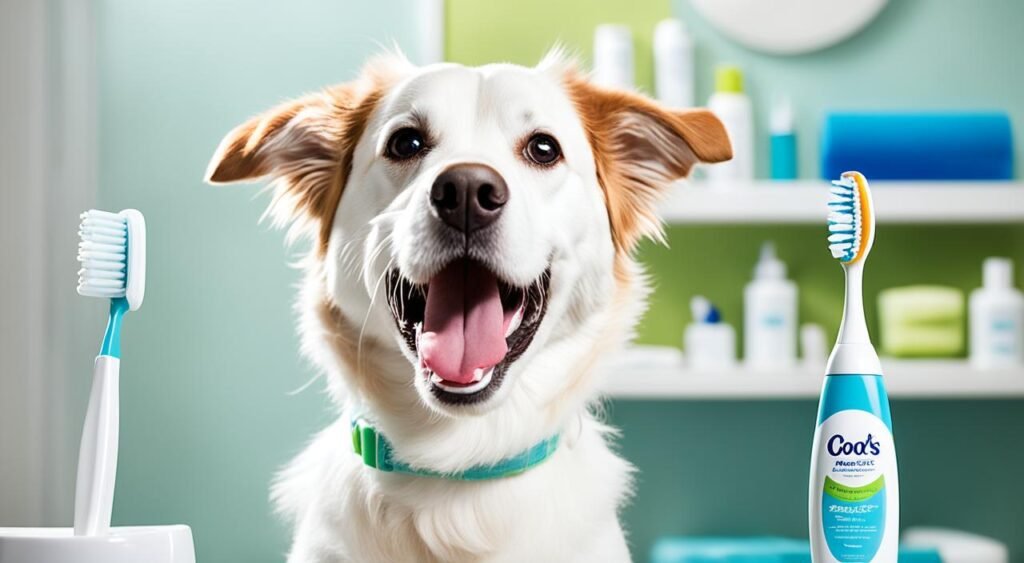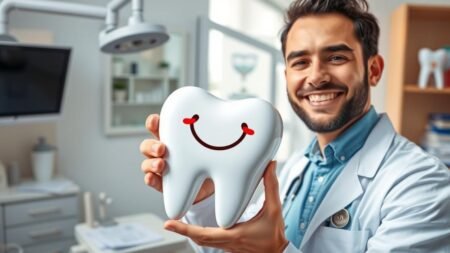Ensuring the health and happiness of your furry friend starts with the essentials, and one key element that shouldn’t be overlooked is their dental care. Just as you maintain your own oral hygiene, establishing a dog toothbrushing routine is critical for their overall well-being. The right toothbrush for dogs not only helps in preventing dental diseases but also contributes to your pet’s longevity and quality of life. Did you know that maintaining clean teeth can actually help your dog live a longer, healthier life?
With a variety of options flooding the market, finding the best toothbrush for dogs can seem overwhelming. But fear not! By the end of this article, you’ll be equipped with the knowledge to choose a toothbrush that suits your dog’s needs perfectly, ensuring their pearly whites stay bright and their gums remain healthy. Let’s dive into the world of canine oral care and discover how a simple routine can make a world of difference to your dog’s smile!
The Importance of Oral Hygiene in Dogs
Maintaining oral hygiene in dogs is not just about fresh breath – it’s a critical component of their overall health. Just like humans, dogs are susceptible to gum disease, which can have a cascade of health effects.
As a pet owner, understanding the dangers your furry friend faces from plaque and tartar is key to preventing dental diseases and ensuring that they enjoy a long, happy life by your side.
Understanding Gum Disease in Dogs
Gum disease, also known as periodontal disease, occurs when plaque—a sticky film of bacteria—builds up on the teeth and hardens into tartar. This can lead to inflammation and eventually destruction of the supporting structures of the teeth.
Without intervention, gum disease can result in severe pain, tooth loss, and can potentially lead to more serious systemic conditions.
How Plaque and Tartar Affect Your Dog’s Health
Plaque and tartar don’t just stay on the teeth – they can enter the bloodstream and affect organs like the heart and kidneys. Regular dental care, including brushing and the use of specific dental health products, can dramatically reduce the buildup of these harmful substances.
Proper oral hygiene in dogs can be the line of defense your dog needs against these health threats.
Signs of Oral Health Issues in Dogs
Some signs that can indicate a problem with your dog’s dental health include bad breath, difficulty eating, bleeding gums, and visible plaque or tartar on the teeth. If you notice any of these symptoms, it’s time to step up your dog’s oral care routine and consult your veterinarian for advice and potential treatment options.
The table below provides a clear comparison between healthy canine teeth and those affected by dental issues. Understanding these differences can help you spot early signs of trouble and take actionable steps to prevent progression to serious conditions.
| Healthy Dog Teeth | Dog Teeth with Gum Disease |
|---|---|
| No discoloration or minimal plaque | Yellow-brown tartar buildup |
| Firm, pink gums | Inflamed, bleeding, or receding gums |
| No bad breath | Persistent bad breath |
| Teeth are intact without mobility | Loose or missing teeth |
By prioritizing oral hygiene in dogs, you can prevent the onset of gum disease and avoid the unsightly and harmful effects of plaque and tartar. Regular veterinary check-ups and proactive dental care are key to your dog’s well-being.
Types of Dog Toothbrushes: Pros and Cons
When you’re in the market for types of dog toothbrushes, the variety can be overwhelming. To make choosing a dog toothbrush an easier task, it’s insightful to understand the various options along with their respective pros and cons.
Traditional dog toothbrushes resemble those used by humans but are specifically designed to accommodate the unique shape and structure of a canine’s mouth. They typically have soft bristles to protect sensitive gums, and some come with angled heads to better reach the back teeth.
- Pros: Good for thorough cleaning, various sizes available, replaceable heads
- Cons: Some dogs may resist, requires manual dexterity for proper use
In contrast, finger toothbrushes fit snugly over your fingertip, giving you better control and sensitivity when brushing your dog’s teeth. This can be especially helpful for smaller breeds or dogs that may not tolerate a longer brush handle.
- Pros: Enhances control, gentle on gums, good for dogs uncomfortable with traditional brushes
- Cons: May not be as effective on hard-to-reach areas, can be chewed by dogs, one-size-fits-all
Dental wipes are another alternative, offering a comfortable way to clean the teeth of dogs who absolutely refuse a brush. While they are convenient, their effectiveness as compared to brushing can vary.
- Pros: Non-invasive, easy to use, good for dogs who dislike brushing
- Cons: Less effective than brushing, can be more costly over time
Remember, the best types of dog toothbrushes for your pet might not be the best for another. Factors like your dog’s size, health, and personal preference will influence your choice. With the right information, choosing a dog toothbrush becomes a simpler process, boosting your dog’s oral health and overall wellbeing.

| Type | Pros | Cons |
|---|---|---|
| Traditional Toothbrush | Effective cleaning, size variety, replaceable heads | Can be resisted by dogs, requires manual skill |
| Finger Toothbrush | Better control, gentle, dog-friendly for most | Not as good for deep cleaning, risk of chewing |
| Dental Wipes | Easy to use, non-invasive, convenient for travel | Less thorough than brushes, potentially costly |
Ultimately, maintaining oral hygiene is key to your dog’s health and happiness. Finding the perfect match for your furry friend’s dental care needs will keep their tail wagging and smile shining for years to come.
Toothbrush for Dogs: Choosing the Right One
When embarking on your journey to maintain your pup’s pearly whites, selecting the best toothbrush for dogs is a crucial step toward effective oral care. The array of toothbrush options available might feel overwhelming, but the right choice ensures comfort during the brushing experience and is fundamental in preventing dental diseases.
Consider your dog’s size and breed when scouring for the optimal toothbrush. Larger breeds with expansive mouths will need a toothbrush with a longer handle and a broader brush head to reach all teeth surfaces, while smaller dogs benefit from more petite brush sizes to navigate their compact oral cavities. The bristle texture is another consideration; softer bristles are generally recommended to avoid gum damage, particularly for dogs with sensitive gums or dental issues.
The design of a toothbrush for dogs can vary significantly and plays a pivotal role in the cleaning process. Some dogs prefer the familiarity of a regular toothbrush shape, while others may be more amenable to a finger toothbrush that allows for greater control and direct contact during brushing. Here is a comparison table to help you weigh your options:
| Type of Toothbrush | Pros | Cons |
|---|---|---|
| Traditional Dog Toothbrush | Long handle for better reach, larger brush head for efficient cleaning | May be intimidating for some dogs, harder to control for delicate areas |
| Finger Toothbrush | Greater control, ideal for brushing sensitive areas, less intimidating size | Not suitable for dogs with a tendency to bite, limited reach inside the mouth |
The best toothbrush for dogs is also one that your four-legged friend feels comfortable using. Start with a soft approach to make the experience as pleasant as possible for both of you. The ease of use is paramount, as regular toothbrushing should be a hassle-free routine, rather than a chore you dread.
- Look for toothbrushes with ergonomic handles to prevent slipping and ensure a secure grip.
- Opt for toothbrushes that are made from non-toxic, dog-safe materials.
- Consider a double-headed toothbrush for dogs to clean multiple surfaces at once.
In conclusion, ensure your toothbrush of choice is adept at removing plaque and promoting overall dental health. A toothbrush that satisfies both effectiveness and comfort can make all the difference. Remember, a good dog toothbrush is an investment in your pet’s well-being and a crucial component of their oral hygiene routine.
How to Introduce a Toothbrushing Routine to Your Dog
Implementing a dog toothbrushing routine is essential for your furry friend’s dental health, yet it can feel like a daunting task for both you and your pet. The key is to gradually introduce the concept, making it a positive experience from day one. Whether it’s a puppy’s first time or an older dog learning new tricks, patience and consistent practice are the cornerstones of successful oral care habits.

Dog Toothbrush, 360º Dog Tooth Brushing Kit, Cat Toothbrush, Dog Teeth Cleaning, Dog Finger Toothbrush, Dog Tooth Brush for Small & Large Pets, Dog Toothpaste Not Included – Blue 2-Pack
SAFE & EFFECTIVE – 100% Silicone is BPA and Phthalate-free.
Step-by-Step Guide to Toothbrushing for Your Dog
Start by letting your dog become familiar with the toothbrush and dental products specifically designed for canine use. You can do this by allowing them to sniff and lick the toothbrush for dogs, which should be the right size and fit for their mouth. Apply a small amount of dog-friendly toothpaste onto the brush to entice them with its flavor.
Then, gently lift their lips and rub the toothbrush in a circular motion against a few teeth. Keep these initial sessions brief and positive, culminating in a reward for their cooperation. Regularity is essential in establishing a thorough dog toothbrushing routine that becomes part of their daily habits.
Overcoming Resistance: Tips for Nervous Dogs
Nervous dogs may need extra persuasion and a gradual approach to accept toothbrushing as part of their routine. Initially, just using a dab of toothpaste on your finger to massage their gums may help. Gradually progress to a finger brush before introducing the actual dog toothbrush.
Each successful step should be met with plenty of praise and some playtime or a favorite treat, which helps in maintaining oral care practices as a positive and expected part of their day.
Maintaining Consistency in Oral Care Practices
Maintaining oral care consistency is crucial in preventing dental issues like plaque, tartar, and gum disease. Set a regular schedule for toothbrushing—ideally daily—and stick to it. Consistent care allows your dog to adjust and accept the routine while ensuring their teeth and gums stay healthy.
Your dedication to their oral hygiene pays off in their improved health and potentially saves on vet bills for dental work in the long run. Remember, a clean and healthy mouth contributes to a happier, healthier pooch.
FAQ
Why is choosing the right toothbrush important for my dog’s oral health?
Selecting the appropriate toothbrush for your dog is crucial because it helps effectively remove plaque and prevent tartar buildup, both of which can lead to gum disease and other oral health issues. The right toothbrush will be comfortable for your dog, making the brushing experience more pleasant for both of you, and ultimately contribute to better dental care.
What is gum disease in dogs and why should I be concerned?
Gum disease, or periodontal disease, is an infection that affects the tissues surrounding the teeth, leading to inflammation, pain, and even tooth loss. If left untreated, it can also lead to more serious systemic health issues. Early detection and preventive care, such as regular toothbrushing, are key to protecting your dog’s health.
How do plaque and tartar affect my dog’s health?
Plaque is a sticky film of bacteria that forms on teeth, which can harden into tartar if not regularly removed. Tartar buildup contributes to gum disease and can cause infections that may spread to other parts of the body. Regular dental care, including brushing, is essential to minimize these risks.
What are the signs of oral health issues in dogs?
Common signs of dental problems in dogs include bad breath, difficulty eating, pawing at the mouth, red or swollen gums, yellow or brown tartar on the teeth, and loose or missing teeth. If you notice any of these symptoms, consult your veterinarian as soon as possible.
What are the different types of dog toothbrushes, and how do I choose?
The main types of dog toothbrushes include traditional handled toothbrushes, finger toothbrushes, and dental wipes. Handle toothbrushes are good for reaching all areas but may not be well-accepted by all dogs. Finger brushes give more control and may be less intimidating for your pet. Dental wipes are a convenient alternative but may not be as effective at removing plaque. Consider your dog’s size, mouth shape, and temperament when choosing a toothbrush.
What factors should I consider when choosing a toothbrush for my dog?
When choosing a toothbrush for your dog, consider the size and breed of your dog, as well as their dental condition. Look for a toothbrush that fits comfortably in your dog’s mouth and has soft bristles to avoid gum irritation. The handle should be long enough for you to reach all teeth, and the brush head should be the right size to access all areas easily.
How should I introduce a toothbrushing routine to my dog?
Begin by letting your dog get accustomed to the taste of pet-safe toothpaste, and gradually introduce the toothbrush. Start with brief sessions, praising and rewarding your dog for cooperation. Gradually increase the time spent brushing and always keep the experience positive. Consistency is key, so try to make toothbrushing a regular part of your dog’s routine.
What should I do if my dog resists toothbrushing?
If your dog is nervous about toothbrushing, start slowly by using your finger to massage their gums and teeth gently. Gradually introduce the toothbrush, using lots of praise and treats to create positive associations. Be patient and never force the process, as this can make resistance worse.
How often should I brush my dog’s teeth?
Ideally, you should brush your dog’s teeth daily to prevent plaque buildup and maintain good oral hygiene. If daily brushing isn’t possible, aim for a minimum of three times per week. Regular brushing can significantly reduce the risk of dental issues and can also be a bonding experience for you and your dog.









3 Comments
Pingback: Dog Dental Chart: Guide to Canine Teeth Health In 2024
Pingback: Find Your Best Mouthwash for Healthy Gums & Teeth
Pingback: The Best Dog Toothbrushes for Healthy Pet Smiles